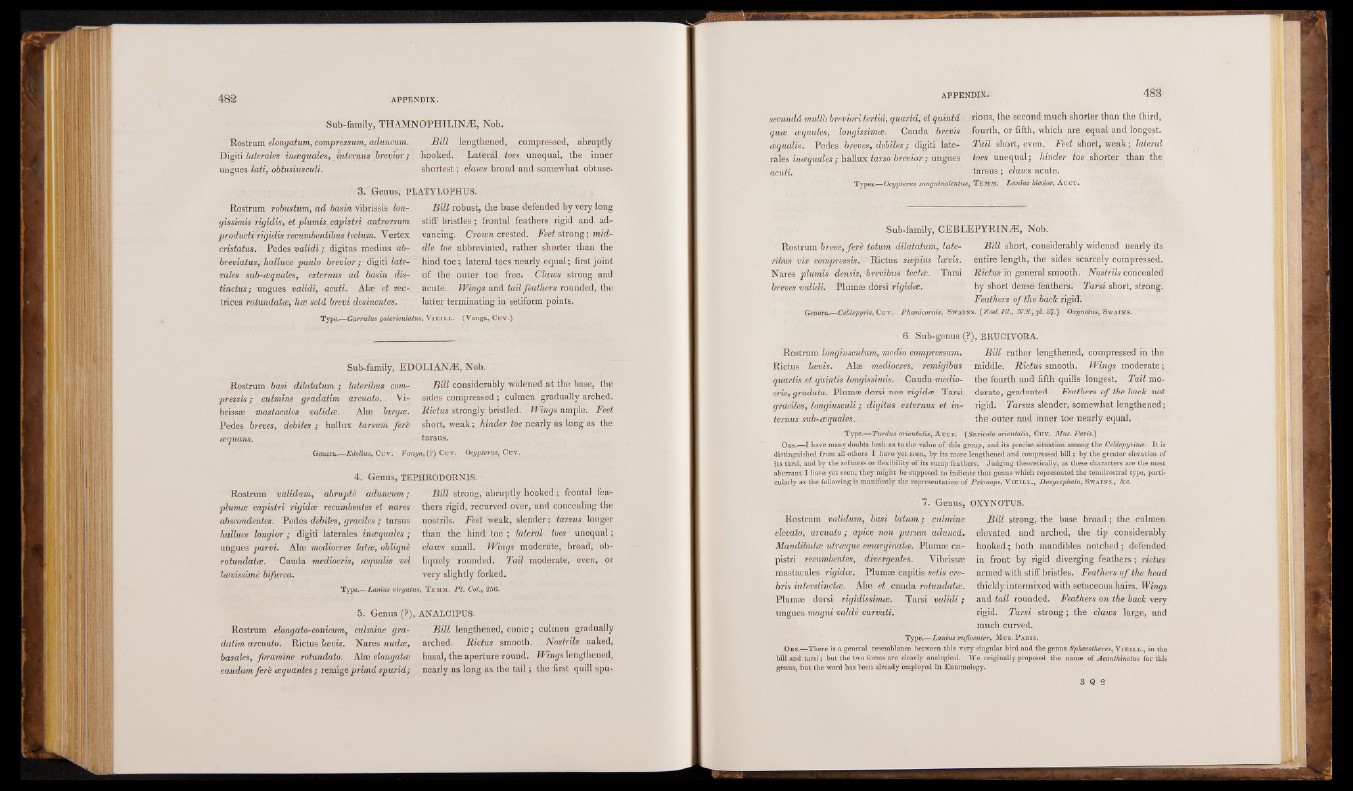
Sub-family, THAMNOPHILIN^E, Nob.
Rostrum elongatum, compressum, aduncum. Bill lengthened, compressed, abruptly
Digiti later ales incequales, internus brevior; hooked. Lateral toes unequal, the inner
ungues lati, obtusiusculi. shortest; claws broad and somewhat obtuse.
3. Genus, P
Rostrum robustum, ad basin vibrissis lon-
gissimis rigidis, et plumis capistri antrorsum
producti rigidis recumbentibus tectum. Vertex
cristatus. Pedes validi; digitus medius abbreviates;
halluce paulo brevior ; digiti late-
rales sub-cequales, externus ad basin dis-
tinctus; ungues validi, acuti. Ai® et rec-
trices rotundatce, hce seta brevi desinentes.
Type.—Garrulus galericula;
ATYLOPHUS.
Bill robust, the base defended by very long
stiff bristles ; frontal feathers rigid and advancing.
Crown crested. Feet strong; middle
toe abbreviated, rather shorter than the
hind toe; lateral toes nearly equal; first joint
of the outer toe free. Claws strong and
acute. Wings and tail feathers rounded, the
latter terminating in setiform points,
s, Vie il l . (Vanga, Cuv.)
Sub-family, EDOLIANiE, Nob.
Rostrum basi dilatatum ; lateribus com- Bill considerably widened at the base, the
pressis; culmine gradatim arcuato. Vi- sides compressed; culmen gradually arched,
brissae mastacales valid#. Alse largce. Rictus strongly bristled. Wings ample. Feet
Pedes breves, debiles ; hallux tarsum fer& short, weak; hinder toe nearly as long as the
cequans. tarsus.
Genera.—Edolius, Cuv. Vanga, (?) Cuv. Ocypterus, Cuv.
4. Genus, TEPHRODORNIS.
Rostrum validum, ahruptè aduncum ;
plumoe capistri rigidoe recumbentes et nares
abscondentes. Pedes débiles, graciles ; tarsus
halluce longior ; digiti latérales inoequales ;
ungues parvi. Alæ médiocres latoe, obliqué
rotundatoe. Cauda mediocris, cequalis vel
loevissimè bifurca.
Bill strong, abruptly hooked; frontal feathers
rigid, recurved over, and concealing the
nostrils. Feet weak, slender; tarsus longer
than the hind toe ; lateral toes unequal;
claws small. Wings moderate, broad, obliquely
rounded. Tail moderate, even, or
very slightly forked.
Type.—Lanins virgatus, Temm. PI. Col., 256.
5. Genus (?), ANALCIPUS.
Rostrum elongato-conicum, culmine gradatim
arcuato. Rictus lasvis. Nares nudce,
basales, foramine rotundato. Alæ elongatoe
caudamferè oequantes ; remige prima spuriâ;
Bill lengthened, conic; culmen gradually
arched. Rictus smooth. Nostrils naked,
basal, the aperture round. Wings lengthened,
nearly as long as the tail; the first quill spusecundd
multb breviori tertid, quarta, et quintd rioUs, the second much shorter than the third,
quce (Equates, longissimce. Cauda brevis fourth, or fifth, which are equal and longest.
cequalis. Pedes breves, debiles; digiti late- Tail short, even. Feet short, weak; lateral
rales incequales; hallux iarso brevior; ungues toes unequal; hinder foe shorter than the
dcuii. tarsus; claws acute.
Types.—Ocypterus sanguinolentus, Temm. Lanius bicolor, Auct.
Sub-family, CEBLEPYRINJE, Nob.
Rostrum breve, fere totum dilatatum, late- Bill short, considerably widened nearly its
ribus vix compressis. Rictus scepius IcEvis. entire length, the sides scarcely compressed.
Nares plumis densis, brevibus tecfce. Tarsi Rictus in general smooth. Nostrils concealed
breves validi. Plumse dorsi rigidce. by short dense feathers. Tarsi short, strong.
Feathers of the back rigid.
Genera.—Ceblepyris, Cuv. Phcenicornis, Swains. {Zool. III., N.S., pi. 57.) Oxynotus, Swains.
6. Sub-genus (?), ERUCIVORA.
Rostrum longiusculum, medio compressum. Bill rather lengthened, compressed in the
Rictus Icevis. Alse mediocres, remigibus middle. Rictus smooth. Wings moderate;
quartis et quintis longissimis. Cauda medio- the fourth and fifth quills longest. Tail mo-
cris, gradata. Plumse dorsi non rigidce. Tarsi derate, graduated. Feathers of the back not
graciles, longiusculi ; digitus externus et in- rigid. Tarsus slender, somewhat lengthened;
ternus sub-cequales. the outer and inner toe nearly equal.
Type.— Turdus orientalis, Auct. (Saxicola orientalis, Cuv. Mus. Paris.)
Obs.—I have many doubts both as to the value of this group, and its precise situation among the Ceblepyrirue. It is
distinguished from all others I have yet seen, by its more lengthened and compressed bill; by the greater elevation of
its tarsi, and by the softness or flexibility of its rump feathers. Judging theoretically, as these characters are the most
aberrant I have yet seen, they might be supposed to indicate that genus which represented the tenuirostral type, particularly
as the following is manifestly the representation of Prionops, Vie il l ., Dasycephala, Swains., &c.
7. Genus, OXYNOTUS.
Rostrum validum, basi latum; culmine
elevato, arcuato ; apice non parum aduncd.
Mandibuloe utroeque emarginatce. Plumæ capistri
recumbentes, divergentes. Vibrissæ
mastacales rigidce. Plumæ capitis setis cre-
bris interstinctce. Alæ et cauda rotundatoe.
Plumæ dorsi rigidissimoe. Tarsi validi ;
ungues magni valdè curvati.
Bill strong, the base broad; the culmen
elevated and arched, the tip considerably
hooked; both mandibles notched; defended
in front by rigid diverging feathers ; rictus
armed with stiff bristles. Feathers of the head
thickly intermixed with setaceous hairs. Wings
and tail rounded. Feathers on the back very
rigid. Tarsi strong; the claws large, and
much curved.
Type.—Lanius rufiventer, Mus. P aris.
Obs.—There is a general resemblance between this very singular bird and the genus Sphecotheres, Vie il l ., in the
bill and tarsi; but the two forms are clearly analogical. We originally proposed the name of Acanthinotus for this
genus, but the word has been already employed in Entomology.